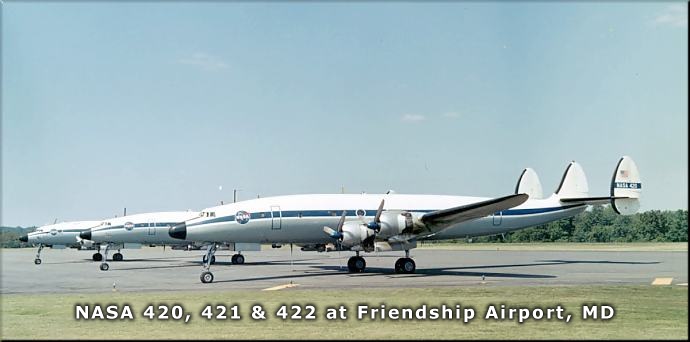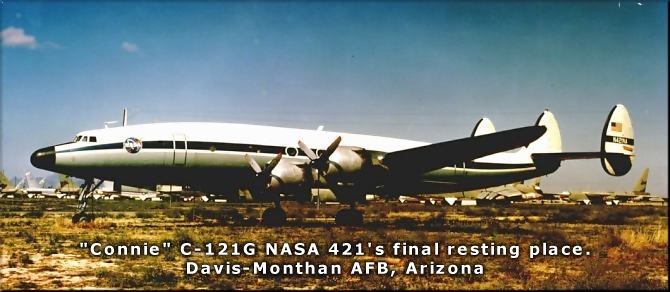The End of a Great Era
This was another sad time in the lives of those who operated or flew on the Lockheed Constellations used by the NASA's Goddard Space Flight Center [GSFC] as dynamic Apollo Simulators to test ground station equipment and train station personnel in the required mission configurations. The first Connie, a C-121G Super Connie was acquired in August 1963 an designated NASA 20, followed by a 2nd C-121G in September 1963. It was given NASA 21 as its call sign. At this time, NASA aircraft were not registered with the FAA, and we flew all over the world just using our NASA number. Eventually the FAA finally caught up with us around 1969, and FAA registration numbers were assigned and NASA 20 became N420NA, but still used the radio call sign of NASA 420. The same arrangement was used for NASA 21.
In 1966 the Apollo Program was really going full blast, and along with the new world wide tracking stations, there were 5 Apollo tracking ships and 8 ARIA aircraft that would need to use the capabilities of the GSFC Connie's. In April 1966 we acquired a third Connie, a C-121A from Davis-Monthan, Arizona to help meet the growing schedule, and it was assigned NASA 422. This particular aircraft had been General Douglas MacArthur's personal aircraft, the BATAAN, and was one of my favorites. I pushed to get the nose art from MacArthur's era put back on, and eventually was successful.
Anyway, attached are some photos of these great aircraft when they were used by GSFC.
The first photo is of NASA 420 at Kindley AFB, Bermuda in Feb. 1968
The 2nd photo is also NASA 420 sitting on the ramp at Strawberry Point, Martin Airport in December 1972, just one month before it was flown to Aberdeen Proving Ground, MD and used by the Army to test results of different explosive devices. I have a rudder pedal from this aircraft mounted on a plaque over my computer.
The next 2 photos are of NASA 422 while our GSFC Aircraft Operations still flew out of Friendship Airport [now BWI], Maryland. Due to early budget cuts, this aircraft was released in February 1970, and was flown to Ft. Rucker, Alabama on 10 March 1970 and turned over to the Army Air Museum for display. It remained here until 23 years later when I received word from a friend doing volunteer work at the museum that a new Curator was going to scrap the BATAAN because it wasn't a helicopter. I immediately called Ed Maloney of the Planes of Fame Museum in Chino, California and told him what was happening to the BATAAN. He called the Curator and confirmed that the story was true, then asked if he could have it for his museum. The Curator told him to come and get it. Fortunately, some of the Ft. Rucker troops had run the engines from time to time, and this helped to keep the bird in pretty good shape. After about 6 months of prep, Maloney's folks took off from Ft. Rucker and ferried it to Dothan, Alabama to finish up more of the long term items. Eventually, the aircraft was restored back to General MacArthur's original configuration, inside and out, and placed on display at the Planes of Fame Museum in Grand Canyon Airport, Arizona.
The final photo is of NASA 421 completing its last NASA Apollo support over the Canarvon, Australia Manned Flight Station in December of 1972.
Prior to flying to Australia, we were working with the Manned Flight Station on the island of Guam in the Pacific. We received word that the decision was made to terminate all Connie operations when we returned to the States. Since our Super Connie's were too heavy for the Canarvon airport runway the Sim Team flew up from Perth [600 miles] by a small commercial aircraft. The folks on the Canarvon station had only seen the Connie at around 10,000 feet and was curious to see it up close. I was able to arrange with the good folks who controlled the air space in that area to allow NASA 421 to make some low passes over the station. I have some photos that show it lower that the main 30-ft USB antenna. The Captain of this particular flight was Charlie Lungren [deceased] a legend in his own time. After several passes by the station, the tower personnel at the airport asked me if Charlie would be kind enough to make a pass over the airport and town. Well, Charlie would never pass up an opportunity like that and dusted off the airport, followed up by a low, low pass down the Main Street of Canarvon. This pass was a great success, with stories received telling about some of the locals almost having cardiac arrest with dishes bouncing off shelves, and other assorted items. It was probably one of the most exciting things that ever happen in the little seaside fishing village. I'm willing to bet there are still old timers at the local pub talking about the time those crazy Yanks almost blew the town away with their noisy flying machine.
Apollo 17 was the swan song for the GSFC Connie's. NASA 421 was the last to go, and left Strawberry Point on 2 February 1973 for McClellan AFB, Sacramento, California. From there it ended up back in Davis-Monthan, Arizona, and was melted down for its scrap value. The sad ending of a great airplane.
Thus the End of a Great Era, along with some Great Memories!!!
Bob Burns
Posted 23 July 2007
![[Image] , 88214 byte(s).](121-2.jpg)
![[Image] , 88214 byte(s).](121-2.jpg)
![[Image] , 58600 byte(s).](121-3.jpg)
![[Image] , 78600 byte(s).](121-4.jpg)
![[Image] , 64577 byte(s).](121-1.jpg)
![[Image] , 51712 byte(s).](121-5.jpg)


![[Image] , 94076 byte(s).](3connies.jpg)